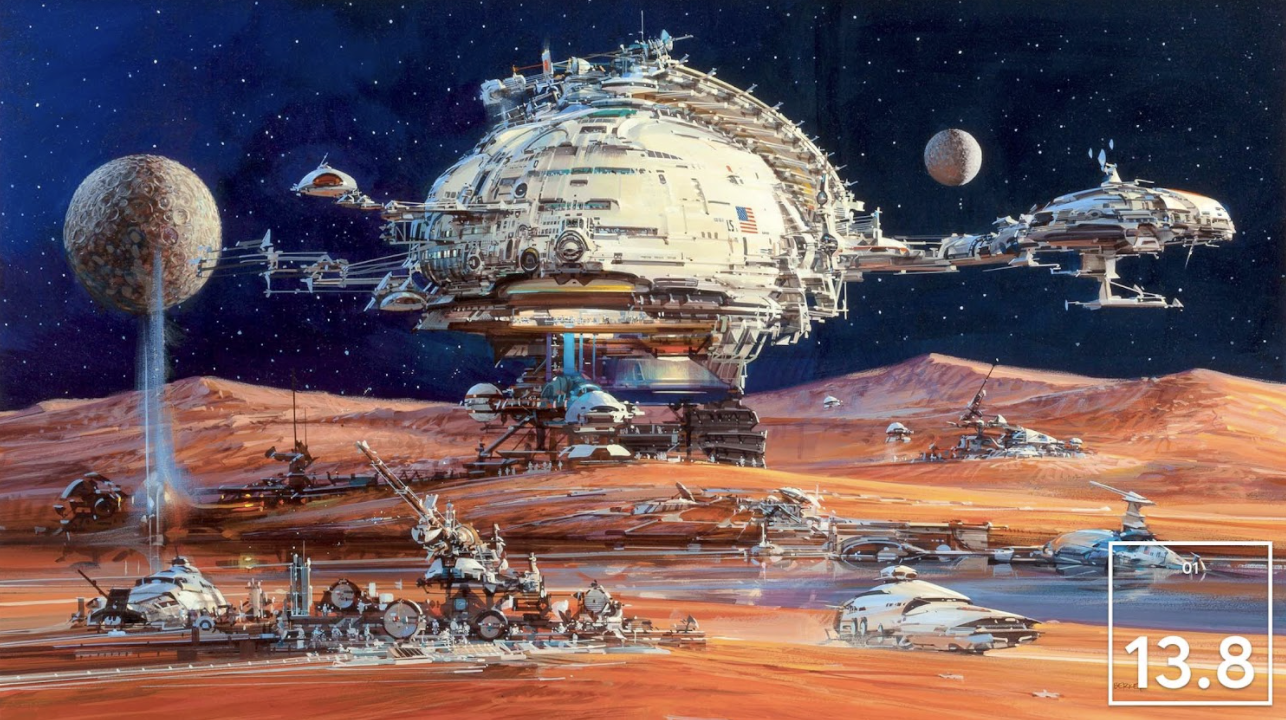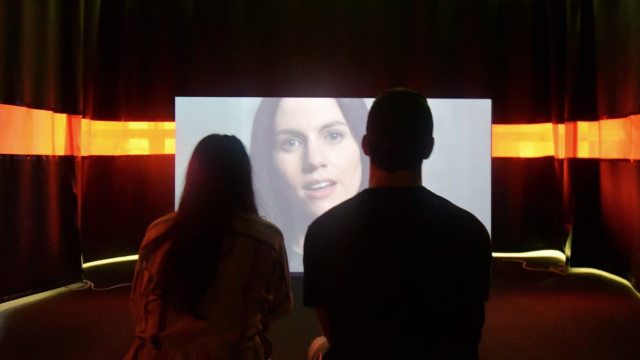Science fiction doesn’t predict the future. It inspires it.

- Many inventions came about after their creators saw them in works of science fiction.
- Cell phones and the Apple Watch were inspired by Dick Tracy's wrist radio.
- Science fiction often inspires the future rather than predicting it.
This article was originally published on our sister site, Freethink.
William Shatner is going to space — and it’s because Jeff Bezos is a Trekkie.
When Bezos was a child, he was fascinated by the works of sci-fi authors such as Isaac Asimov and Robert A. Heinlein, who wrote about futures for humanity that weren’t bound to Earth’s surface.
Those books sparked a love for sci-fi that led to another obsession: Star Trek.
“Jeff started Amazon just to get enough money to do Blue Origin.”
URSULA WERNER
When Bezos wasn’t reading, he was with his friends, pretending to be the characters from his favorite television show. By the time he finished high school, his plan to build space colonies was formed enough to warrant inclusion in his valedictorian speech.
“Jeff started Amazon just to get enough money to do Blue Origin,” Bezos’ high school girlfriend Ursula Werner claimed. “He was intrigued by the idea of rocketing into outer space.”
“I can’t prove her wrong,” Bezos said later.
From sci-fi to reality
On July 20, at the age of 57, Bezos made his sci-fi-inspired dream a reality as one of four people aboard Blue Origin’s New Shepard rocket during its very first crewed mission into space.
The follow-up flight is scheduled for October 12, and this time, Bezos is offering up a seat to Shatner, who portrayed Captain James T. Kirk on Star Trek.
“I’ve heard about space for a long time now,” the actor, now 90 years old, said. “I’m taking the opportunity to see it for myself. What a miracle.”
“Science fiction inspired scores, hundreds, perhaps thousands of people to study, to become engineers.”
KEN MACLEOD
Sci-fi’s influence on Bezos isn’t limited to Blue Origin — Amazon’s AI-powered personal assistant Alexa was inspired by Star Trek’s voice-activated computer — and this relationship exemplifies how the genre doesn’t so much “predict” the future as it inspires it.
Sci-fan fans see something in the creative works, and then they figure out how to make them a reality. Bezos saw Star Trek’s computer as a child, thought it was cool, and today, you can ask Alexa to order you a pizza.
“Science fiction inspired scores, hundreds, perhaps thousands of people to study, to become engineers,” science fiction writer Ken MacLeod told Big Think. (Bezos, again, was one of them — he studied electrical engineering and computer science at Princeton.)
But as MacLeod noted, he’s far from alone. Here are a few other notable inventions that might not exist if their creators hadn’t seen them first in a work of science fiction.
Rocket man
American engineer Robert H. Goddard (for whom NASA’s Goddard Space Flight Center is named) is often credited with ushering in the space age, having designed — and launched — the first liquid-fueled rocket.
“It made a deep impression … The spell did not break, and I took up physics.”
ROBERT H. GODDARD
His fascination with spaceflight was triggered by some of the very earliest pieces of science fiction.
“In 1898, I read your War of the Worlds,” Goddard wrote in a letter to author H. G. Wells. “I was 16 years old [and] it made a deep impression. The spell was complete a year afterward, and I decided that what might conservatively be called ‘high-altitude research’ was the most fascinating problem in existence.”
“The spell did not break, and I took up physics … how many more years I shall be able to work on the problem I do not know; I hope, as long as I live,” he continued. “There can be no thought of finishing, for ‘aiming at the stars,’ both literally and figuratively, is a problem to occupy generations.”
Cell phones & smart watches
Star Trek is often credited with inspiring a device that’s probably in your hand right now — the cell phone — but its creator, Martin Cooper, says he actually got the idea from a piece of sci-fi gadgetry in a comic book: Dick Tracy’s wrist radio.
It took decades for that inspiration to pay off, but in 1973, when Cooper was the head of Motorola’s communications systems division, he placed the first cellular phone call from a hefty 2.4 pound device that eventually evolved into the sleek smartphones that are now ubiquitous.
“I have been wanting to do this since I was 5 years old. The day is finally here.”
TIM COOK
Tracy’s wrist radio also inspired another of today’s tech gadgets: the Apple Watch.
“I have been wanting to do this since I was 5 years old,” Apple CEO Tim Cook said when unveiling the device, referring to his childhood fascination with the Dick Tracy comics. “The day is finally here.”
Music on PCs
Before Apple released QuickTime in 1991, no one was playing music or videos on their personal computers — but inventor Steve Perlman was inspired to create the tech that would allow the devices to compress, store, and playback media by, of course, Star Trek.
“They didn’t know how to make a computer do this … that’s our job.”
STEVE PERLMAN
“[The character] Data was listening to many copies of music simultaneously played through the speakers,” he said in the TV documentary How William Shatner Changed the World. “The idea that he could call up any music he wanted on the computer in the Enterprise was a novel idea.”
“The Next Generation is my favorite Star Trek series — these guys were dreaming of stuff that wasn’t obvious and showing how it could be used,” Perlman added. “Now, they didn’t know how to make a computer do this and how to figure out all the logistics of it, of course — that’s our job.”
The modern submarine
The first submarines could only operate for short distances near shore, but in 1898, U.S. inventor Simon Lake demonstrated how his Argonaut could travel hundreds of miles underwater in the open sea.
“Jules Verne was in a sense the director-general of my life.”
SIMON LAKE
His inspiration for the craft came from sci-fi pioneer Jules Verne.
“Jules Verne was in a sense the director-general of my life,” Lake’s autobiography, Submarine, quotes him as saying. “When I was not more than ten or eleven years old, I read his Twenty Thousand Leagues under the Sea, and my young imagination was fired.”
“I began to dream of making voyages under the waters … but with the impudence which is a part of the equipment of the totally inexperienced, I found fault with some features of Jules Verne’s Nautilus and set about improving on them,” he continued.
Unforgettable helicopters
In 1939, Russian emigre Igor Ivanovich Sikorsky built the world’s first helicopter, but his inspiration for the craft came decades earlier, when he read a different novel by Verne, at the age of 10 or 11.
“Anything that one man can imagine, other men can make real.”
JULES VERNE
“It was called ‘Clipper of the Clouds,’ and in it, Jules Verne had invented a helicopter-like vehicle,” Igor’s son Sergei Sikorsky told the New York Times in 1995. “My father referred to it often. He said it was ‘imprinted in my memory.’”
“He often quoted something else from Jules Verne,” Sikorsky added. “‘Anything that one man can imagine, another man can make real.’”





